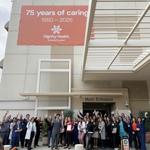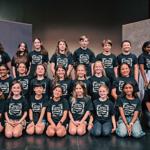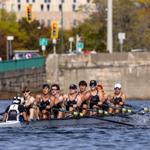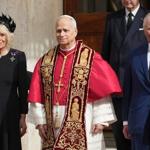When John Kaitz took over as the high school boys’ coach for the Redwood City-based NorCal Crew club, he wanted his rowers to raise their level, expectations and goals.
“They were so committed to beating Los Gatos and Marin (club teams). That was their whole world,” said Kaitz, who crewed collegiately before coaching at University of Southern California and UC Santa Barbara.
“We said we’re going to go bigger.”
The NorCal eights boat put itself on the map with a strong showing in its first-ever appearance the Henley Regatta in England this past the summer, the oldest regatta in the world.
Last week, NorCal Crew opened eyes, once again, with standout performances at the Head of the Charles Regatta, which is the world’s largest regatta held on the Charles River in Massachusetts — a regatta which started in 1965 and this year had nearly 2,700 entries from nearly 900 clubs from around the world.
NorCal’s eights — comprised of coxswain Jasper Tam and rowers Henry Pecore, Ethan Heller, Alex Ochoa, Hank Allison, Thor Dakin, Peter Ward, Marco Alataris and Liam Bai – finished fourth out of 85 teams.
“Which was outstanding. The youth eights in one of the more competitive events,” Kaitz said. “Our time would have placed us second in the collegiate eight (race). It’s that fast and we beat last year’s NorCal time.”
The boys’ four — Coxswain Minka Ottoveggio and rowers Miles Sosnowski, Oliver Lundgren, Sebastian Boom and Soren Phillips — finished 12th in the fastest NorCal time ever in that event.
The Mx Inclusive 2x, a para-crew boat for NorCal, consisting of TC Gunther and Hayden Htun, finished fifth.
NorCal also sent two girls’ boats, with the eights team finishing middle of the pack in 49th, while the fours team took second.
Tam, a senior at Serra, who coxed the eights at last year’s Head of the Charles, was even better this year, Kaitz said. The coxswain is essentially the driver of the boat, with the rowers serving as the engine. And unlike other events and regattas that are held on design-specific crew courses or dammed lakes, the Head of the Charles, like England’s Henley, is raced in “live” water — the Charles River in Massachusetts and the River Thames in England.
That means boats have to navigate currents, as well five bridge tunnels over the 4,800-meter course that Kaitz said is as exhilating as any sports event you’ll find.
“There is a crowd for about three miles,” Kaitz said. ‘There are five bridges (boats go under) and people are packed on the bridges.
Recommended for you
I’ve raced it in college and I never had experience like that.”
Unlike other events in which boats race each other, the Head of the Charles in a race against the clock. Boats go out every 10 seconds and not only are teams racing the clock, they have to do so while navigating traffic. Kaitz said there is one bridge tunnel that can accommodate only one boat at a time because the oars nearly touch the sides of the undercrossing.
In addition to the racing, the Head of the Charles in also known for crashes among boats and bridges.
“There is a carnage video [race organizers] put up every year,” Kaitz said. “Fiberglass hitting concrete is not pretty. … I’ve seen boats T-bone other boats. It’s pretty scary.
“We call it ‘NASCAR on the water.’”
Additionally, the race is not a straight 4,800 meters. There are twists and turns as the crews follow the natural course of the river — which includes a nearly 180-degree turn near the end of the course.
All of which makes driving the boat that much more difficult for coxswains like Tam.
“It’s such a difficult course to see for a coxswain,” Kaitz said. “They have to think 70 feet ahead. It’s twisting and turning.”
But that live water also presents an opportunity for experienced crews and coxswains. The course’s distance is measured from the center of the river. And the fastest boats aren’t rowing the entire 4,800 meters. There are plenty of opportunities to shave meters and seconds off the course. Kaitz estimated that the NorCal eights boat covered about 200 meters less than the 4,800 meters, with Tam literally cutting corners.
“[Tam] raced it last year, so he’s used to it,” Kaitz said. “He worked hard and he stepped up. He was great.”
Kaitz said he wanted to raise the profile of NorCal Crew as a way to get more American athletes into boats at the collegiate level. Beating other local club teams don’t drive much interest among college coaches. But do well at the Henley and the Head of the Charles?
Coaches are blowing up Kaitz’s email.
“My personal goal is to make sure our college programs get more US rowers instead of international athletes,” Kaitz said. “There has been an influx of international rowers. I’d like to try to change that.”





























(0) comments
Welcome to the discussion.
Log In
Keep the discussion civilized. Absolutely NO personal attacks or insults directed toward writers, nor others who make comments.
Keep it clean. Please avoid obscene, vulgar, lewd, racist or sexually-oriented language.
Don't threaten. Threats of harming another person will not be tolerated.
Be truthful. Don't knowingly lie about anyone or anything.
Be proactive. Use the 'Report' link on each comment to let us know of abusive posts.
PLEASE TURN OFF YOUR CAPS LOCK.
Anyone violating these rules will be issued a warning. After the warning, comment privileges can be revoked.